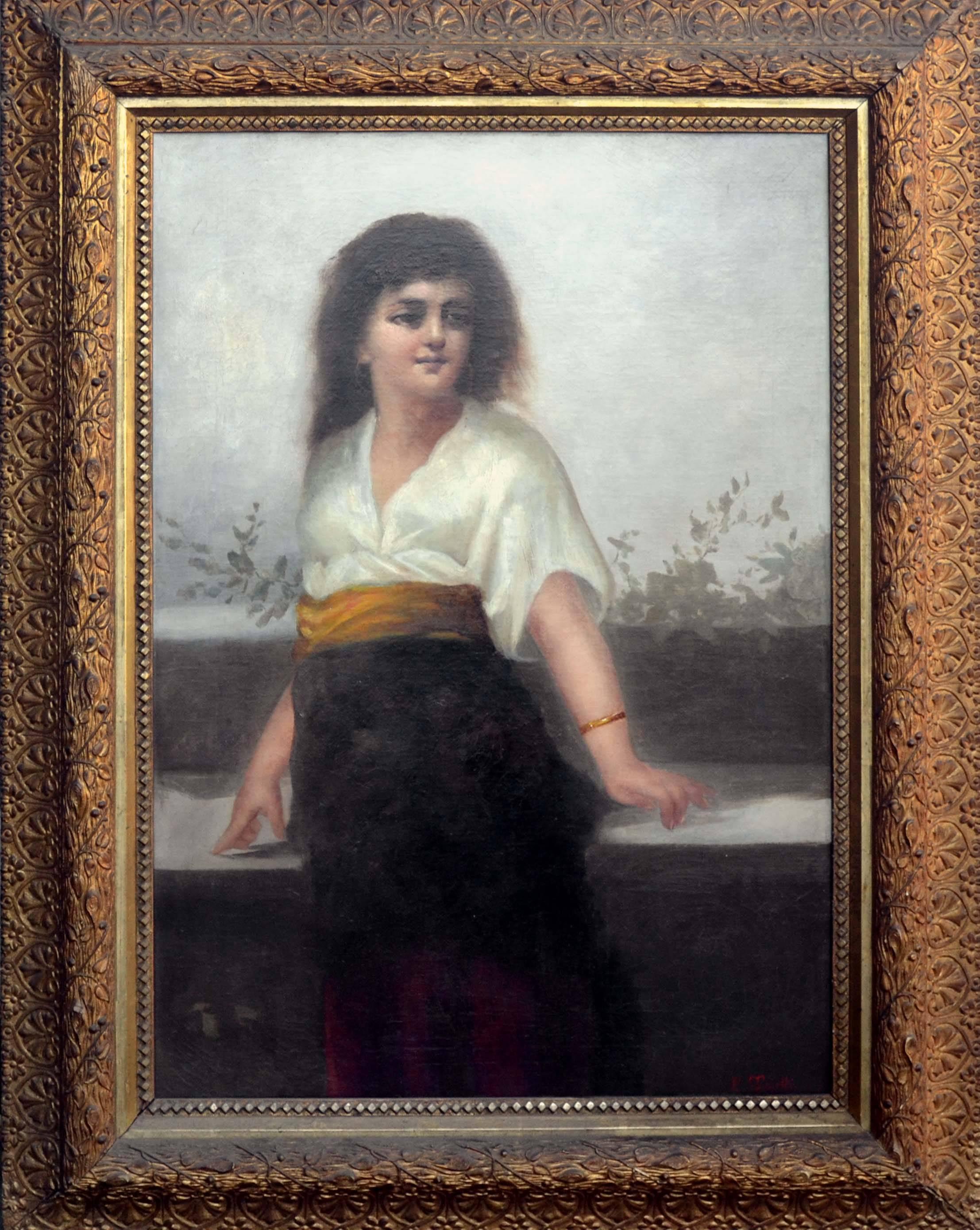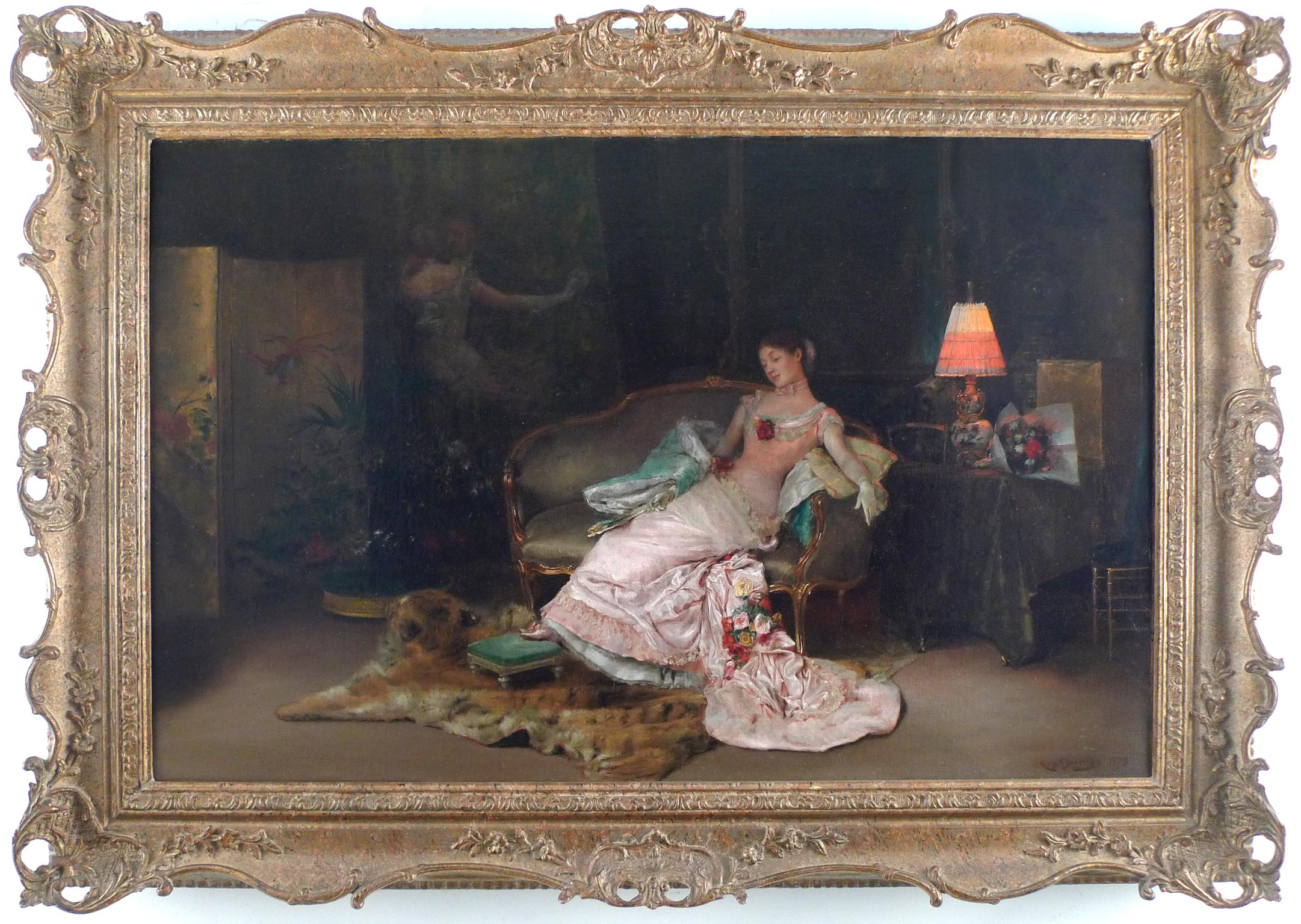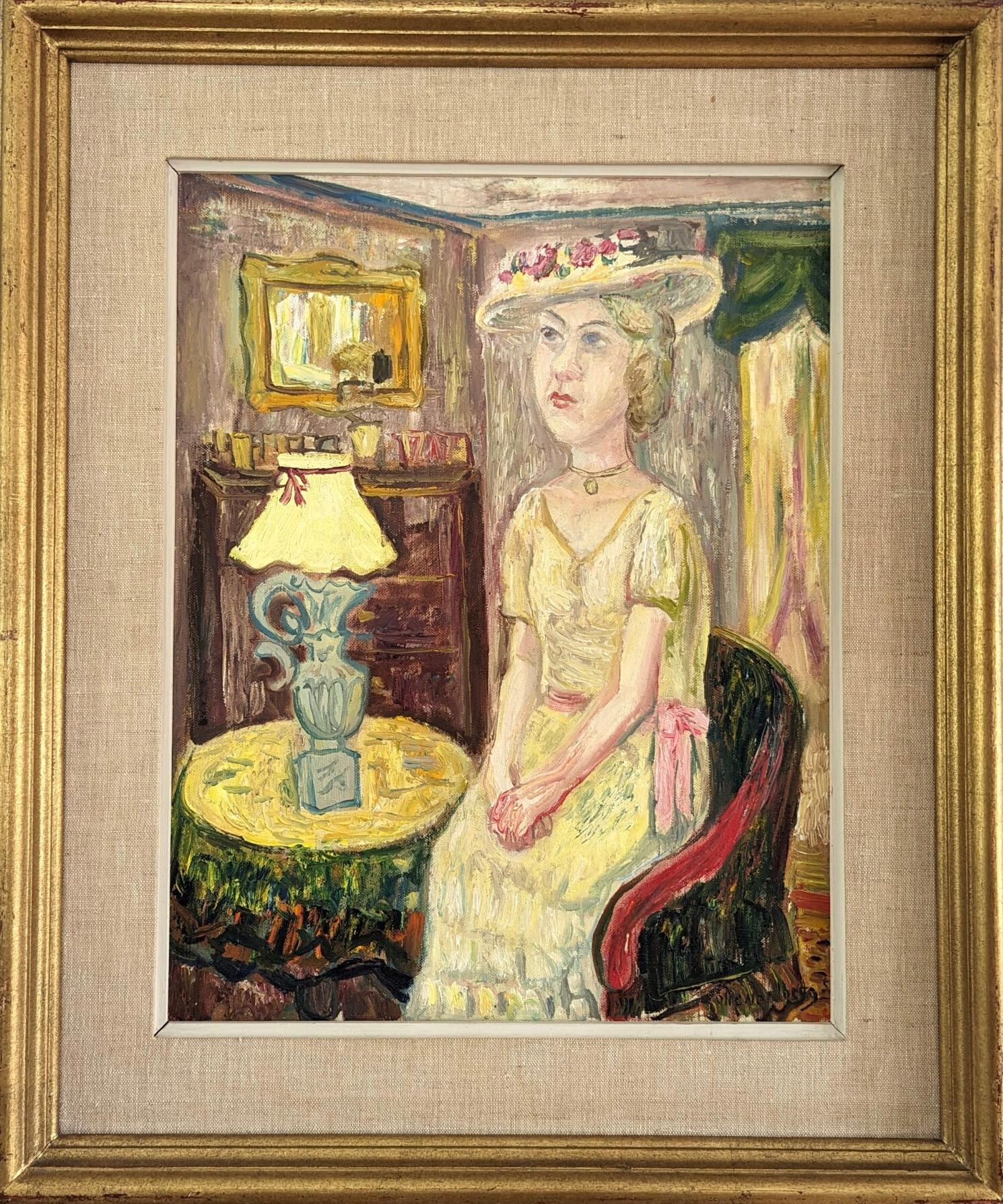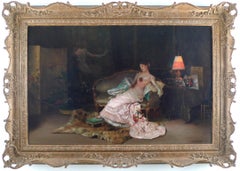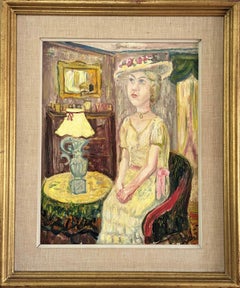Items Similar to "Lady in yellow", 19th Century oil on panel by Rogelio de Egusquiza y Barrena
Want more images or videos?
Request additional images or videos from the seller
1 of 15
Rogelio de Egusquiza y Barrena"Lady in yellow", 19th Century oil on panel by Rogelio de Egusquiza y BarrenaCirca 1880
Circa 1880
$71,888.61
£53,516.40
€60,000
CA$98,469.43
A$109,519.50
CHF 57,187.68
MX$1,332,735.84
NOK 730,373.95
SEK 684,961.91
DKK 456,759.05
Shipping
Retrieving quote...The 1stDibs Promise:
Authenticity Guarantee,
Money-Back Guarantee,
24-Hour Cancellation
About the Item
ROGELIO DE EGUSQUIZA Y BARRENA
LADY IN YELLOW
signed "R. Egusquiza" (lower right)
oil on panel
28-5/8 X 20-3/4 inches (72.5 X 52.7 cm.)
framed: 32-5/8 X 24-3/4 inches (82.5 X 62.5 cm.)
Rogelio de Egusquiza y Barrena (1845 – 10 February 1915) was a Spanish painter, known for his friendship with the German composer Richard Wagner, whose works he helped make familiar in Spain
He was born in El Astillero, into a well-to-do family. He studied in Madrid and with Léon Bonnat at the École des Beaux-Arts in Paris. In 1868, after travelling and participating several times in the National Exhibition of Fine Arts, he returned to Paris and settled there. At first, he painted historical scenes, but later turned to genre scenes and portraits in the Academic style.
Following the death of Marià Fortuny, he moved to Rome at the invitation of the Madrazos, Raimundo and Ricardo, taking Fortuny's place at their studio through 1875 and attending classes at the Spanish Academy in Rome.
He heard Wagner's music for the first time in 1876, after returning to Paris. Three years later, he travelled to Munich to hear a performance of The Ring of the Nibelungen. His enthusiasm for what he heard led him to go to Bayreuth, where he introduced himself to Wagner and became his friend. In the following years, he and Wagner got together again several times; in Venice (1880), Berlín (1881) and Bayreuth (1882); where he was a guest at the premiere of Parsifal.
After his first meeting with Wagner, he decided to devote his career to doing works on Wagnerian themes; mostly portraits of the characters rather than specific scenes. During his visits to Germany, he also created portraits of Arthur Schopenhauer (posthumous) and King Ludwig II of Bavaria and wrote an article for the newsletter Bayreuther Blätter called "Über die Beleuchtung der Bühne" (On Stage Lighting).
He participated in the Salons de la Rose + Croix in 1892, 1893, 1896 and 1897, and presented prints from Parsifal at the Exposition Universelle (1900), winning a silver medal. Although he lived in Paris, he was a frequent visitor to Madrid and was part of a circle of Wagnerian admirers that met at the Lhardy restaurant.
When the "Asociación Wagneriana de Madrid" was established in 1911, he presented them with copies of voice and piano versions of several operas and one hundred etchings of his portrait of Wagner (based on a familiar photograph), to be sold to benefit the association. Later, he was made an honorary member.
He remained in Paris until 1914, when World War I forced him to return to Spain. He died in Madrid the following year. From 2013 to 2014, in celebration of Wagner's 200th birthday, the Museo del Prado presented an exhibition of Egusquiza's works called "El Mal se desvanece" (Evil fades), which included several portraits of classical literary figures as well as his Wagnerian works.
Oil on panel by Rogelio de Egusquiza executed in an exquisite and brilliant precious technique.
These types of female portraits, had an enormous success among Parisian high society.
The composition is very fortunyana and baroque, with several tapestries that hang at the bottom of the room and cultured and refined elements such as the piano and the beautiful furniture that are guessed at the bottom.
The rich and ornate fabrics of the young woman's dress are painted with a precious and delicate technique, such as the bright colorful of the yellow dress and the lace of the "mantilla".
The sad attitude of the lady is also linked to the poetic and somewhat dramatic temperament of the artist.
- Creator:Rogelio de Egusquiza y Barrena (1845 - 1915)
- Creation Year:Circa 1880
- Dimensions:Height: 28.55 in (72.5 cm)Width: 20.75 in (52.7 cm)
- More Editions & Sizes:72,5 X 52,7 cm.Price: $89,861
- Medium:
- Movement & Style:
- Period:
- Condition:
- Gallery Location:Madrid, ES
- Reference Number:1stDibs: LU128114766522
About the Seller
5.0
Vetted Professional Seller
Every seller passes strict standards for authenticity and reliability
Established in 1977
1stDibs seller since 2019
21 sales on 1stDibs
Typical response time: 2 hours
- ShippingRetrieving quote...Shipping from: Madrid, Spain
- Return Policy
Authenticity Guarantee
In the unlikely event there’s an issue with an item’s authenticity, contact us within 1 year for a full refund. DetailsMoney-Back Guarantee
If your item is not as described, is damaged in transit, or does not arrive, contact us within 7 days for a full refund. Details24-Hour Cancellation
You have a 24-hour grace period in which to reconsider your purchase, with no questions asked.Vetted Professional Sellers
Our world-class sellers must adhere to strict standards for service and quality, maintaining the integrity of our listings.Price-Match Guarantee
If you find that a seller listed the same item for a lower price elsewhere, we’ll match it.Trusted Global Delivery
Our best-in-class carrier network provides specialized shipping options worldwide, including custom delivery.More From This Seller
View All"A Reverie During The Ball", 19th Century Oil on Canvas by Rogelio Egusquiza
By Rogelio de Egusquiza y Barrena
Located in Madrid, ES
ROGELIO DE EGUSQUIZA
Spanish, 1845 - 1915
A REVERIE DURING THE BALL
signed and dated "Rogelio Egusquiza, 1879" (lower right)
oil on canvas
21-3/4 X 3...
Category
1870s Symbolist Figurative Paintings
Materials
Canvas, Oil
Eduardo León Garrido, "An Elegant Dance", 19th C. Oil on Mahogany Wood Panel
By Eduardo Leon Garrido
Located in Madrid, ES
EDUARDO LEÓN GARRIDO
Spanish, 1856- 1949
AN ELEGANT DANCE
signed "E. L Garrido" (lower right)
oil on mahogany wood panel
25-1/8 x 32 inches (63.5 x 81 cm.)
framed: 31 x 38 inches (78.5 x 96 cm.)
PROVENANCE
Private Spanish Collector
Eduardo León Garrido (Madrid, 1856 - Caen, 1949) was a Spanish painter. He began his training at the Higher School of Painting in Madrid and as a disciple in Vicente...
Category
1890s Realist Figurative Paintings
Materials
Oil, Wood Panel
"Elegant Figures Seated in a Park" 19th Century Oil on Panel by M. Alonso Pérez
By Mariano Alonso Pérez
Located in Madrid, ES
MARIANO ALONSO PÉREZ
Spanish, 1857 - 1930
ELEGANT FIGURES SEATED IN A PARK
signed, located and dated "Alonso Pérez, Paris ´91" (lower right)
oil o...
Category
Early 1900s Romantic Landscape Paintings
Materials
Oil, Wood Panel
"The Painter and his Model", 19th C. Oil on Mahogany Wood Panel by E. L. Garrido
By Eduardo Leon Garrido
Located in Madrid, ES
EDUARDO LEÓN GARRIDO
Spanish, 1856- 1949
THE PAINTER AND HIS MODEL
signed "E. L Garrido" (lower right)
oil on mahogany wood panel
19-3/4 x 24-1/8 inches (50 x 61 cm.)
framed: 28-1/2 x 32-3/4 inches (72 x 83 cm.)
PROVENANCE
Private Spanish Collector
Eduardo León Garrido (Madrid, 1856 - Caen, 1949) was a Spanish painter. He began his training at the Higher School of Painting in Madrid and as a disciple in Vicente Palmaroli...
Category
Early 1900s Realist Figurative Paintings
Materials
Oil, Wood Panel
"La hora del té", 19th Century oil on canvas by Ricardo Brugada y Panizo
Located in Madrid, ES
RICARDO BRUGADA Y PANIZO
Spanish, 1867 - 1919
LA HORA DEL TÉ
signed & dated "Ricardo Brugada. 1897." (lower left)
oil on canvas
22-1/8 x 31.5 inches (5...
Category
1890s Realist Landscape Paintings
Materials
Canvas, Oil
"Interieur aux Fleurs Jaunes" 20th Century Oil on Canvas by Emilio Grau Sala
By Emilio Grau Sala
Located in Madrid, ES
EMILIO GRAU SALA
Spanish, 1911 - 1975
INTERIEUR AUX FLEURS JAUNES
signed "Grau Sala" (lower left)
signed again, located, dated and titled "Grau Sala, Paris 61, Interieur aux fleurs jaunes" (on the reverse)
oil on canvas
15 x 18-1/4 inches (38 x 46 cm.)
framed: 23-1/2 x 26-1/2 (59.5 x 67 cm.)
PROVENANCE
Private Parisian Collection
Interieur aux fleurs jaunes
This interior with two female figures where also the plans made in different colors are drawing the composition.
The abundant pictorial material distributed in geometric portions, gives life to the tablecloth and mother and daughter figures, in black and white colors of the jacket, while the black line takes care of the environments so as not to separate them.
The fruit bowl and flowers give a cheerful touch with their pastel tones.
Emilio Grau Sala came from a family of artists. He was born in Barcelona in 1911 and his father, a good cartoonist, had been one of the promoters of the "Salon des Humanistes" and made his exhibitions normally in "Sala Parés", Barcelona.
His first works were exhibited at the Salon des Independents. In the years 1930-33 he had painted under the influence of Cubism, especially that of Torres García. It is from that time a painting of the port of Barcelona, geometric and structural, which completely anticipated what would later be his work. His personality began fully painting watercolors and oils with a certain fantasy character, with a point of decorative instinct and themes full of naivety and grace. Romantic interiors, paddocks, port scenes, sailors, etc.
Grau Sala was essentially a Mediterranean painter, son of post-impressionism and enriched with French painting of the last fifty years. Mediterranean because his work has the color and light of that land.
He understood and assimilated impressionist painting very well, and for that reason he was never subject to the modules of a formulist realism, nor the sexigencias of the forms.
In Paris he found the best environment to give us a fruitful and intense work, because he could use the expressive potential of French art to enrich it.
All this made him a very esteemed artist everywhere where his work was known. He was also very often required to illustrate books and publications in Paris. Also his posters were very successful.
He painted a large number of subjects, but perhaps the theme of horse racing is where you can see in a very clear way the joyful and optimistic life that was lived at that time. In this fabric there is an explosion of juicy and vivid colors full of ingenuity and simplicity in its composition. Only a teacher could turn the complicated into something simple and beautiful. Before this work we feel a deep emotion, the emotion of before starting a horse race. Joy and nervousness at the same time. Especially since it is a direct emotion. There are no intermediaries between our eyes and what the work intends to tell us. This is precisely what seduces and catches us of this painting.
His works can be found in the Museums of the Villa de Paris, L'Ile de France Museum, at the Château de Sceaux, Honfleur Museum, La Rochelle Museum, Barcelona Museum...
Category
1960s Fauvist Interior Paintings
Materials
Canvas, Oil
You May Also Like
Portrait of a Young Lady in Yellow - French 1900 Victorian art oil painting
Located in London, GB
This stunning French Victorian portrait oil painting is by noted exhibited female artist Jeanne Rongier. This delicately detailed portrait is of the head and shoulders of a beautiful young woman, gazing to her right. Painted from a low vantage point looking up, the background is a superb canopy of illuminated green and yellow leaves with the light shining through them and all around her. Her dark glossy hair against the light drenched leaves is beautiful in a very Victorian Pre Raphaelite tone. A thoroughly charming portrait oil painting by a noted French Victorian female artist depicting a female sitter...
Category
Early 1900s Realist Portrait Paintings
Materials
Oil
$10,139 Sale Price
20% Off
Girl with the Gold Sash, Late 19th Century Large-Scale Female Figurative
By Eduardo Tojetti
Located in Soquel, CA
Girl with the Gold Sash, Late 19th Century Large-Scale Female Figurative
Late 19th century Romanic portrait of a young girl by Eduardo Tojetti (American/Italy, 1851-1930), c.1880. T...
Category
19th Century Victorian Figurative Paintings
Materials
Oil, Linen
Portrait of a Young Lady in a Yellow Dress - British Victorian art oil painting
By Sir William Blake Richmond
Located in London, GB
This lovely British Victorian Pre-Raphaelite portrait oil painting is by Royal Academy artist Sir William Blake Richmond. Painted circa 1900 it is a stunning example of his work with...
Category
Early 1900s Impressionist Portrait Paintings
Materials
Oil
Vintage Mid-Century Figurative Interior Oil Painting - Lady in Yellow
Located in Bristol, GB
LADY IN YELLOW
Size: 56 x 46 cm (including frame)
Oil on Board
A quirky and well-executed mid-century modernist portrait composition, painted in oil onto board.
In this painting we...
Category
Mid-20th Century Modern Figurative Paintings
Materials
Oil, Board
Lady in Yellow Portrait - British 50's Impressionist oil painting female artist
By Pauline Glass
Located in London, GB
A superb oil on panel by Pauline Glass who was educated on the continent at the Academy Julien and who exhibited throughout her career. This stunning oil is a bold, adventurous and c...
Category
Mid-20th Century Impressionist Portrait Paintings
Materials
Oil
The Spanish Flower Girl. An antique oil painting on canvas
By Eduardo Leon Garrido
Located in St. Albans, GB
Eduardo León GARRIDO
(French, Madrid 1856-1949 Caen)
Picture Size: 16 x 13" (41 x 33cm)
Outside Frame Size: 22 x 19" (56 x 48cm)
Eduardo León Garrido was born in Madrid in 1856. He...
Category
Early 20th Century Mannerist Figurative Paintings
Materials
Oil
More Ways To Browse
Woman Painting On Oil Panel
Antique Fabric Panel
19th Century Painting Music
Spanish Lady Art
Late 19th Century Spanish Painting
Restaurant Scenes Oil Paintings
Lady Dior In Black
19th Century Oil Paintings Rose
Wagner Painted
Fortuny Paintings
19th Century Painted Tapestry
Signed Wagner Painting
1900 Portrait Of A Woman Oil
Portrait Of A Lady Spain
Piano 1900
Leon Bonnat
Antique Spanish Tapestry
Antique Class Ring

